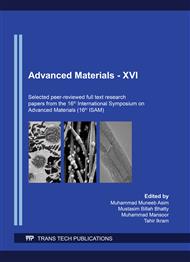[1]
R Casati, M.Vedani, Metal Matrix Composites Reinforced by Nano-Particles-A Review, Metals (Basel) (2014) 65-83.
DOI: 10.3390/met4010065
Google Scholar
[2]
B.G. Demczyk, M.Wang, J.Cumingd, M.Hetamn, W.Han, A.Zettl, e. al., Direct mechanical measurements of the tensile strength and elastic modulus of multi-walled carbon nanotubes, Mater Sci. Eng. A, 334 (2002) 173–178.
DOI: 10.1016/s0921-5093(01)01807-x
Google Scholar
[3]
B. Abbasipour, B. Niroumand, S.M. Monir Vaghefi, S.M.M. Vaghefi, Compocasting of A356-CNT composite, Trans. Nonferr. Met. Soc. China, 20 (2010) 1561-1566.
DOI: 10.1016/s1003-6326(09)60339-3
Google Scholar
[4]
H. Abou Bakr, e. al., Microstructure and mechanical properties of MWCNTs reinforced A356 aluminum alloys cast nanocomposites Fabricated by using a combination of rheocasting and squeeze casting techniques., J. Nanomat. 1(2014).
DOI: 10.1155/2014/386370
Google Scholar
[5]
M. Mansoor, M. Shahid, Carbon nanotube-reinforced aluminum composite produced by induction melting, J. App. Res. Tech., (2016) 10.1016/j.jart.2016.1005.1002.
DOI: 10.1016/j.jart.2016.05.002
Google Scholar
[6]
R.George, K.T. Kashyap, R.Y.S. Rahul, Strengthening in carbon nanotube/aluminium (CNT/Al) composites, Scripta Materiala 53 (2005) 1159–1163.
DOI: 10.1016/j.scriptamat.2005.07.022
Google Scholar
[7]
Z.Y. Liu, B.L. Xiao, W.G. Wang, Z.Y.Ma, Singly dispersed carbon nanotube/aluminum composites fabricated by powder metallurgy combined with friction stir processing, Carbon 50 (2012) 1843–1852.
DOI: 10.1016/j.carbon.2011.12.034
Google Scholar
[8]
D.Lahiri, S.R.R. Bakshi, K.K. Keshri, Y.Liu, A.Agarwal, Dual strengthening mechanisms induced by carbon nanotubes in roll bonded aluminum composites, Mat. Sci. Eng. A 52 (2009) 263-270.
DOI: 10.1016/j.msea.2009.06.006
Google Scholar
[9]
M. Shahid, M. Mansoor, Induction melting as a fabrication route for aluminum-carbon nanotubes nanocomposite, Int. J. Chem. Mol. Nucl. Mat. and Metal. Eng., 10 (2016) 659-664.
Google Scholar
[10]
M.Mansoor, M.Shahid, Optimization of ethanol flow rate for improved catalytic activity of Ni particles to synthesize MWCNTs using a CVD reactor, Ibro-American J. of Mat. Res. 17 (2014) 739-746.
DOI: 10.1590/s1516-14392014005000070
Google Scholar
[11]
C.Suryanarayana, M.N. Grant, X-ray Diffraction: A Paractical Approach, Springer Science+Business Media, New York, (1988).
Google Scholar
[12]
R.J. Arsenault, N.Shi, Dislocation generation due to differences between the coefficients of thermal expansion, Mat. Sci. Eng. 81 (1986) 175-187.
DOI: 10.1016/0025-5416(86)90261-2
Google Scholar
[13]
L.B. Dutrow, M.C. Clark, X-ray Powder Diffraction in, http://serc.carleton.edu/research_education/geochemsheets/techniques/XRD.html (2014).
Google Scholar
[14]
N. Hansen, Hall-Petch relation and boundary strengthening, Scripta Materiala 51 (2004) 801-806.
DOI: 10.1016/j.scriptamat.2004.06.002
Google Scholar
[15]
G.E. Dieter, Mechanical Metallurgy, 2nd ed., McGraw Hills, (1978).
Google Scholar
[16]
E.H. Rhoderick, R.H. Williams, Metal Semiconductor Contacts, 2nd ed., Clarendon Press, Oxford, (1988).
Google Scholar


